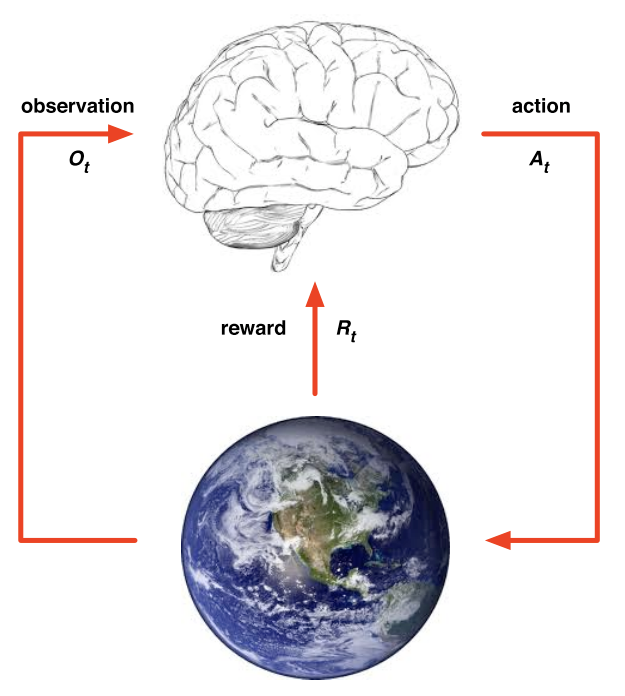Notes of lectures by D. Silver. A brief introduction of RL.
Introduction to Reinforcement Learning
Characteristics v.s. ML
- No supervisor, only a reward signal
- Feedback is delayed, not instantaneous
- Time really matters (sequential, non i.i.d data)
- Agent’s action affect the subsequent data it receives
RL problem
Rewards
- A reward is a scalar feedback signal
- Indicates how well agent is doing at step $t$
- The agent’s job is to maximize cumulative reward
RL is based on reward hypothesis, i.e. All goals can be described by the maximization of expected cumulative reward.
Sequential Decision making
- Goal: select actions to maximize total future reward
- Actions may have long term consequences
- Reward may be delayed
- It may be better to sacrifice immediate reward to gain more long-term reward
Environments
- At each time step $t$ the agent:
- executed action
- Receives observations
- Receives scalar reward
- The environment:
- receives action
- emits observation
- emits scalar reward
- $t$ increments at env. step

State
The history is the sequence of observations, actions, rewards
- i.e. all observable variables up to time $t$
- i.e. the sensorimotor stream of a robot or embodied agent
- What happens depends on the history:
- The agent selects actions
- The environment selects observations / rewards
- State is the information used to determine what happens next. Formally, state is a function of the history:
Environment state
The environment state is the environment’s private representation, i.e. whatever data the environment uses to pick the next observation / reward.
- The environment state is not usually visible to the agent. Even if is visible, it may contain irrelevant information.
Agent state
The agent state is the agent’s internal representation.
- i.e. whatever information the agent uses to pick the next action.
- i.e. it is the information used by RL algorithms.
- It can be any function of history
Information state
An information state (a.k.a.Markov state) contains all useful information from the history.
Definition: A state is Markov if and only if
- “The future is independent of the past given the present”
- Once the state is known, the history may be thrown away, i.e. the state is a sufficient statistic of the future
- The environment state is Markov
- The history is Markov
Fully observable environment
Fully observability: agent directly observes environment state;
- Agent state = environment state = information state
- Formally, this is a Markov decision process (MDP)
Partially observable environments
Partially observability: agent indirectly observes environment. e.g.:
- A robot with camera vision is not told its absolute location.
- A trading agent only observes current prices.
Not agent state $\neq$ environment state.
- Formally, this is a partially observable Markov decision process (POMDP).
- Agent must construct its own state representation , e.g.
- Complete history
- Beliefs of environment state:
- Recurrent neural net:
RL agent
Major component
- Policy: agent’s behavior function
- Value function: how good is each state and/or action
- Model: agent’s representation of the environment
Policy
- A policy is the agent’s behavior
- it is a map from state to action, e.g.
- Deterministic policy:
- Stochastic policy:
Value function
- Value function is a prediction of future reward
- Used to evaluate the goodness / badness of states
- Therefore to select between actions, e.g.
Model
A model predicts what the environment will do next
- $\mathcal{P}$ predicts the next state
- $\mathcal{R}$ predicts the next (immediate) reward, e.g.
RL agent category 1
- Value based
- No policy (implicit)
- Value function
- Policy based
- Policy
- No value function
- Actor Critic
- Policy
- Value function
RL agent category 2
- Model Free
- Policy and/or Value Function
- No Model
- Model based
- Policy and/or Value Function
- Model

Problems within RL
Leaning and Planning
Two fundamental problems in sequential decision making
- Reinforcement learning
- The environment is initially unknown
- The agent interacts with the environment
- The agent improves its policy
- Planning
- A model of the environment is known
- The agent performs computations with its model (without any external interaction)
- The agents improves its policy
- a.k.a. deliberation, reasoning, introspection, pondering, thought, search
Exploration and Exploitation
- RL is like trial-and-error learning
- The agent should discover a good policy
- From its experiences of the environment
Without losing too much reward along the way
Exploration finds more information about the environment; exploitation exploits known information to maximize reward
- It is usually important to explore as well as exploit.
